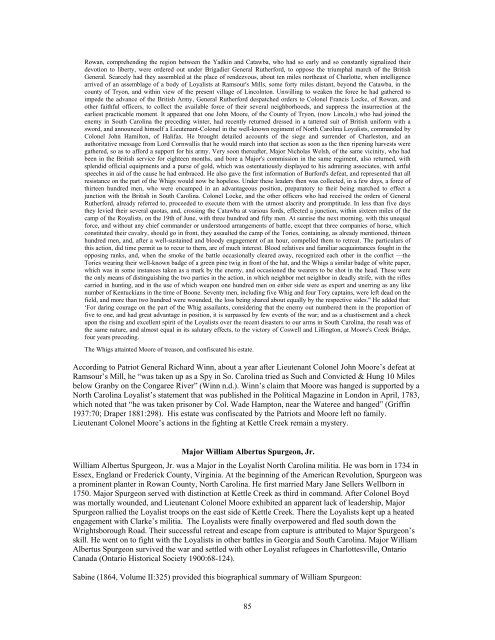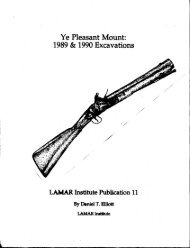Stirring Up a Hornet's Nest: - UGA Laboratory of Archaeology ...
Stirring Up a Hornet's Nest: - UGA Laboratory of Archaeology ...
Stirring Up a Hornet's Nest: - UGA Laboratory of Archaeology ...
Create successful ePaper yourself
Turn your PDF publications into a flip-book with our unique Google optimized e-Paper software.
Rowan, comprehending the region between the Yadkin and Catawba, who had so early and so constantly signalized their<br />
devotion to liberty, were ordered out under Brigadier General Rutherford, to oppose the triumphal march <strong>of</strong> the British<br />
General. Scarcely had they assembled at the place <strong>of</strong> rendezvous, about ten miles northeast <strong>of</strong> Charlotte, when intelligence<br />
arrived <strong>of</strong> an assemblage <strong>of</strong> a body <strong>of</strong> Loyalists at Ramsour's Mills, some forty miles distant, beyond the Catawba, in the<br />
county <strong>of</strong> Tryon, and within view <strong>of</strong> the present village <strong>of</strong> Lincolnton. Unwilling to weaken the force he had gathered to<br />
impede the advance <strong>of</strong> the British Army, General Rutherford despatched orders to Colonel Francis Locke, <strong>of</strong> Rowan, and<br />
other faithful <strong>of</strong>ficers, to collect the available force <strong>of</strong> their several neighborhoods, and suppress the insurrection at the<br />
earliest practicable moment. It appeared that one John Moore, <strong>of</strong> the County <strong>of</strong> Tryon, (now Lincoln,) who had joined the<br />
enemy in South Carolina the preceding winter, had recently returned dressed in a tattered suit <strong>of</strong> British uniform with a<br />
sword, and announced himself a Lieutenant-Colonel in the well-known regiment <strong>of</strong> North Carolina Loyalists, commanded by<br />
Colonel John Hamilton, <strong>of</strong> Halifax. He brought detailed accounts <strong>of</strong> the siege and surrender <strong>of</strong> Charleston, and an<br />
authoritative message from Lord Cornwallis that he would march into that section as soon as the then ripening harvests were<br />
gathered, so as to afford a support for his army. Very soon thereafter, Major Nicholas Welsh, <strong>of</strong> the same vicinity, who had<br />
been in the British service for eighteen months, and bore a Major's commission in the same regiment, also returned, with<br />
splendid <strong>of</strong>ficial equipments and a purse <strong>of</strong> gold, which was ostentatiously displayed to his admiring associates, with artful<br />
speeches in aid <strong>of</strong> the cause he had embraced. He also gave the first information <strong>of</strong> Burford's defeat, and represented that all<br />
resistance on the part <strong>of</strong> the Whigs would now be hopeless. Under these leaders then was collected, in a few days, a force <strong>of</strong><br />
thirteen hundred men, who were encamped in an advantageous position, preparatory to their being marched to effect a<br />
junction with the British in South Carolina. Colonel Locke, and the other <strong>of</strong>ficers who had received the orders <strong>of</strong> General<br />
Rutherford, already referred to, proceeded to execute them with the utmost alacrity and promptitude. In less than five days<br />
they levied their several quotas, and, crossing the Catawba at various fords, effected a junction, within sixteen miles <strong>of</strong> the<br />
camp <strong>of</strong> the Royalists, on the 19th <strong>of</strong> June, with three hundred and fifty men. At sunrise the next morning, with this unequal<br />
force, and without any chief commander or understood arrangements <strong>of</strong> battle, except that three companies <strong>of</strong> horse, which<br />
constituted their cavalry, should go in front, they assaulted the camp <strong>of</strong> the Tories, containing, as already mentioned, thirteen<br />
hundred men, and, after a well-sustained and bloody engagement <strong>of</strong> an hour, compelled them to retreat. The particulars <strong>of</strong><br />
this action, did time permit us to recur to them, are <strong>of</strong> much interest. Blood relatives and familiar acquaintances fought in the<br />
opposing ranks, and, when the smoke <strong>of</strong> the battle occasionally cleared away, recognized each other in the conflict —the<br />
Tories wearing their well-known badge <strong>of</strong> a green pine twig in front <strong>of</strong> the hat, and the Whigs a similar badge <strong>of</strong> white paper,<br />
which was in some instances taken as a mark by the enemy, and occasioned the wearers to be shot in the head. These were<br />
the only means <strong>of</strong> distinguishing the two parties in the action, in which neighbor met neighbor in deadly strife, with the rifles<br />
carried in hunting, and in the use <strong>of</strong> which weapon one hundred men on either side were as expert and unerring as any like<br />
number <strong>of</strong> Kentuckians in the time <strong>of</strong> Boone. Seventy men, including five Whig and four Tory captains, were left dead on the<br />
field, and more than two hundred were wounded, the loss being shared about equally by the respective sides." He added that:<br />
‘For daring courage on the part <strong>of</strong> the Whig assailants, considering that the enemy out numbered them in the proportion <strong>of</strong><br />
five to one, and had great advantage in position, it is surpassed by few events <strong>of</strong> the war; and as a chastisement and a check<br />
upon the rising and excellent spirit <strong>of</strong> the Loyalists over the recent disasters to our arms in South Carolina, the result was <strong>of</strong><br />
the same nature, and almost equal in its salutary effects, to the victory <strong>of</strong> Coswell and Lillington, at Moore's Creek Bridge,<br />
four years preceding.<br />
The Whigs attainted Moore <strong>of</strong> treason, and confiscated his estate.<br />
According to Patriot General Richard Winn, about a year after Lieutenant Colonel John Moore’s defeat at<br />
Ramsour’s Mill, he “was taken up as a Spy in So. Carolina tried as Such and Convicted & Hung 10 Miles<br />
below Granby on the Congaree River” (Winn n.d.). Winn’s claim that Moore was hanged is supported by a<br />
North Carolina Loyalist’s statement that was published in the Political Magazine in London in April, 1783,<br />
which noted that “he was taken prisoner by Col. Wade Hampton, near the Wateree and hanged” (Griffin<br />
1937:70; Draper 1881:298). His estate was confiscated by the Patriots and Moore left no family.<br />
Lieutenant Colonel Moore’s actions in the fighting at Kettle Creek remain a mystery.<br />
Major William Albertus Spurgeon, Jr.<br />
William Albertus Spurgeon, Jr. was a Major in the Loyalist North Carolina militia. He was born in 1734 in<br />
Essex, England or Frederick County, Virginia. At the beginning <strong>of</strong> the American Revolution, Spurgeon was<br />
a prominent planter in Rowan County, North Carolina. He first married Mary Jane Sellers Wellborn in<br />
1750. Major Spurgeon served with distinction at Kettle Creek as third in command. After Colonel Boyd<br />
was mortally wounded, and Lieutenant Colonel Moore exhibited an apparent lack <strong>of</strong> leadership, Major<br />
Spurgeon rallied the Loyalist troops on the east side <strong>of</strong> Kettle Creek. There the Loyalists kept up a heated<br />
engagement with Clarke’s militia. The Loyalists were finally overpowered and fled south down the<br />
Wrightsborough Road. Their successful retreat and escape from capture is attributed to Major Spurgeon’s<br />
skill. He went on to fight with the Loyalists in other battles in Georgia and South Carolina. Major William<br />
Albertus Spurgeon survived the war and settled with other Loyalist refugees in Charlottesville, Ontario<br />
Canada (Ontario Historical Society 1900:68-124).<br />
Sabine (1864, Volume II:325) provided this biographical summary <strong>of</strong> William Spurgeon:<br />
85










